Nothing Is Cooler Than Raising Exotic Chickens!
Exotic Chickens will vary depending where you are in the world. The popularity, variety and heartiness of chicken breeds around the world is really quite amazing. Each culture has brought their unique sense of artistic creativity to the domesticated chicken. Generations of humans have worked fantasy-like details into breeds, leaving some of us wondering: Why? The only answer I come up with is: Why not?
As with dog breeds developed around the globe, climate, life-style and use are written into genetic codes as different breeds emerge from ancient DNA. Some chicken breeds closely resemble their wild Asian ancestors, the Red Junglefowl. (Why improve on perfection?)
But there are some breeds that bear so little physical likeness to their ancestors and popular breeds, that at first sight, any of us could wonder if what we are seeing really is a chicken.
To get a more in depth look at many of the exotic chickens listed here, take a look at our poultry breeds page. Exotic means non-native to a continent. So, American breeds are exotic outside the Americas.
Polish:
Female Mature Weight: up to 4.5 lbs.
Egg Color: White
One of the most beautiful of all exotic chickens and of ancient origin is the Polish breed. They have large crests that really stand out and make them unique. They are quiet and calm birds, partly because their large crest restricts their vision. We own quite a few and they are entertaining, although it can be some what annoying when they can't find their way back to the chicken coop.
Varieties:

White Crested Black Polish:
These adult birds give off a great contrast with their white crests and shiny black bodies. Raising chickens like the white crested black polish can add variety to your flock.
Golden Polish:
These are one of the most ornamental types of Polish Chicken. They are very showy and useful layers of white eggs.

Silver Polish:
The silver Polish are one of the most striking in appearance. The plumage is silvery white and each feather is laced with a shiny black. Hens lay white eggs and are non-setters.

Buff Laced Polish:
These exotic chickens are rare and have a plumage that is buff and laced with a creamy off-white color. They have blue shanks and toes. They have flowing crests and our one of the most unusual breeds that you can own. They are easy to handle and lay white eggs. They are non-setters.

White Polish:
Some call these guys "Snowballs." They are pure white and are one of the daintiest of the polish variety. We actually named one of ours "Q-tip." They are personable and entertaining exotic chickens.
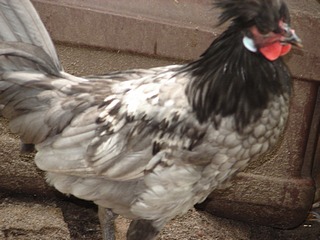
Mottled Houdans:
Class: Continental
Male Mature Weight: up to 8 lbs.
Female Mature Weight: up to 6.5 lbs.
Egg Color: White
These guys originate from Houdan, France. They have a lovely black plumage and many of the feathers are tipped with white spots, hence the "mottled" name. Their top hats and fifth toe give them a very unique appearance. They are good layers of white eggs.
Crevecoeurs:
Class: Continental
Male Mature Weight: up to 8 lbs.
Female Mature Weight: up to 6.5 lbs.
Egg Color: White
Another Frenchie, these guys originated in Normandy, France. They are a rare breed and very similar in size to the Houdan. They don't have the fifth toe though. They lay white eggs.
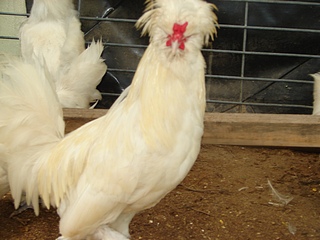
Sultans:
Class: Standard
Male Mature Weight: up to 6 lbs.
Female Mature Weight: up to 4 lbs.
Egg Color: White
The Sultans originated in Southeastern Europe. They are an extremely rare breed and get their name because they were favored by the rulers of Turkey. They have a crest, muffed beard, feathered shanks, and a fifth toe.
Cochins:
Class: Asiatic
Male Mature Weight: up to 11 lbs.
Female Mature Weight: up to 8.5 lbs.
Egg Color: Brown
These are some big exotic chickens. They originally came from China and our covered with an abundance of soft, fluffy feathers from head to toe. They are poor layers.
They come in quite a few varieties including: blue, silver laced, buff, partridge, white, and black.
French Black Copper Maran:
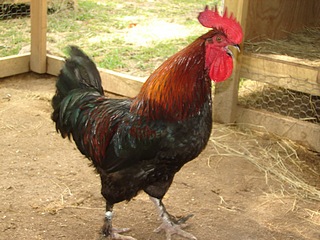
This is one of the rarest breeds of exotic chickens in the United States and it has become very popular because of the price that the eggs fetch.
These dark brown (almost chocolate) eggs can bring from $40 to up to $200 for a half dozen. There are a few breeders of these beautiful birds here in Georgia and they all agree that these unique birds are both beautiful and profitable.
These birds come from France where they are relatively common. French chefs use their eggs often, but eating them in the U.S., because of the price, is left up to the celebrities and other wealthy folks who can afford them.
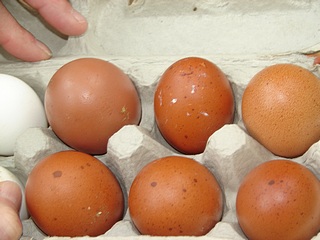
Cuckoo Maran:
Class: Not a Standard Breed
Male Mature Weight: up to 7 lbs.
Female Mature Weight: up to 6 lbs.
Egg Color: Dark Brown
Like the Black Copper Maran this variety of Maran was developed in France. This beautiful bird resembles the barred rock and also lays a dark colored, almost chocolate egg.
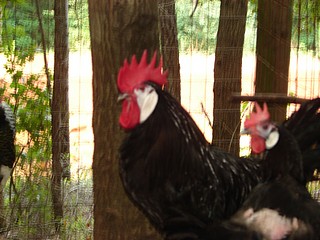
White Faced Black Spanish:
Class: Mediterranean
Male Mature Weight: up to 8 lbs.
Female Mature Weight: up to 6.5 lbs.
Egg Color: White
The Spanish are a graceful and stylish breed. They are rich and glossy black and have a large red comb with a white face. These birds are non-setters and lay a white egg.
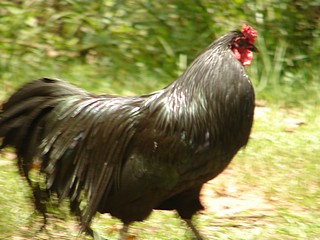
Sumatras:
Class: All Other Standard
Male Mature Weight: up to 5 lbs.
Female Mature Weight: up to 4 lbs.
Egg Color: White
This breed came from the island of Sumatra in southeast Asia. This is a big, graceful bird with a lustrous green sheen on it's dark black feathers. They have a small comb and wattle. They are a rare breed and are very beautiful. They also always seem to have a little wild spunk in them.
To us in the Americas, used to our own classic style of home-grown Heritage breeds, fanciful exotic chickens from other lands can captivate our interest.
Upon seeing them we desire to add their unusual looks to our own chicken yards and coops and learn of the characteristics that make them like and unlike the breeds we’ve been used to seeing.
It might be their feathering style or the unusual type of feathers, like the fluffy Chinese Silky, or the array of colors, sizes and shapes that earn our interest.
It might be the amazingly long tail and saddle feathers of the Onagadori from Japan or the European Phoenix that dazzle us with wonder. It seems that for many of us, we can name our favorite breed from a long list of many.
For 8000 years the chicken has cooperated well with man, especially those who feel the need to design their own new and favorite breed.

Custom Search
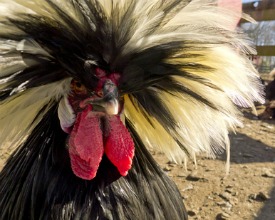



New! Comments
Have your say about what you just read! Leave me a comment in the box below.